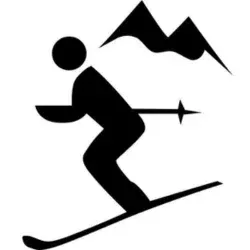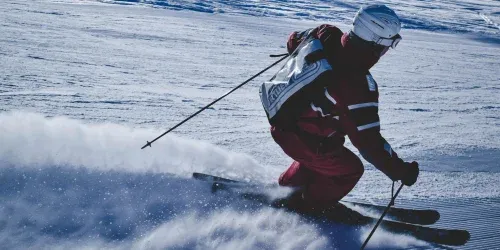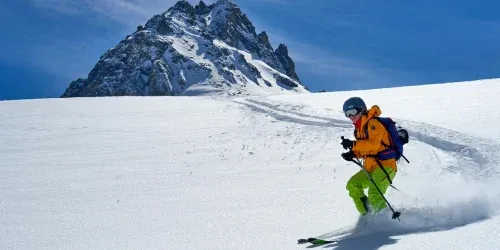Ski poles are an essential tool for skiers of all levels. They aid in balance, timing, and power. However, knowing how to use ski poles effectively can make a huge difference in your skiing experience. This article will guide you through the basics of pole usage, from choosing the right length to executing a perfect pole plant.
Key Takeaways:
- Understanding the correct technique for using ski poles can significantly improve balance and control on the slopes.
- Pole plants are crucial for maintaining rhythm and initiating turns, especially when skiing moguls or making short turns.
- The right ski pole length and grip are essential for effective pole use and to prevent strain or injury.

Choosing the Right Ski Pole Length
Selecting the right length of ski poles is the first step to skiing with confidence. To check if you have the correct length, turn the ski pole upside down and grab it right below the basket. Your elbow should be at a 90-degree angle. If your arm is too high or too low, you may need to adjust the length. Poles that are too long or too short can throw off your balance and make it harder to control your speed and direction.
The Basics of Holding Your Ski Poles
The way you hold your ski poles can impact your skiing technique. Hold the pole with a relaxed grip, allowing your wrist to flex naturally. Your arms should be in front of you, but not stretched out. Keep them at a comfortable distance from your body, with elbows slightly bent. This position helps you maintain balance and prepares you for effective pole planting.
The Art of Pole Planting
Pole planting is a technique used to maintain a nice rhythm and to initiate turns. As you approach a turn, lightly tap the snow with the tip of the pole on the same side as the direction you're turning. This action, known as a blocking pole plant, helps you pivot around the pole, providing a point of reference for your skis to follow. It's a subtle movement, but when done correctly, it can help you maintain control and develop a smooth, flowing style.
Timing Your Pole Plants
Timing is everything when it comes to pole planting. The plant should happen just before the initiation of your next turn. If you plant too early or too late, it can throw off your rhythm and affect your balance. Watch a ski instructor or video tutorials to get a sense of the timing, and practice on a gentle slope until you feel comfortable with the motion.

Ski Poles and Edge Control
When it comes to mastering the art of skiing, understanding how to use your ski poles in conjunction with your edges is crucial. Edges are the sharpened sides of your skis that dig into the snow and allow you to turn, stop, and control your speed. During a ski lesson, instructors often emphasize the importance of using your poles to enhance edge control. By timing your pole plants as you initiate a turn, you create a rhythm that helps you engage your edges more effectively. This technique allows skiers to carve cleaner turns and maintain stability on the piste.
Moreover, ski poles can act as a physical reminder to keep your body aligned over your skis. This alignment is essential for effective edge use. When you plant your pole down the hill, it encourages your body to lean into the turn, which in turn helps to engage the edges of your downhill ski. This is particularly important when skiing on icy or hard-packed slopes where edge grip is vital for preventing a fall. Remember, the poles are there to complement your movements, so use them to reinforce your edge control for a smoother, more precise skiing experience.
Navigating the Piste with Ski Poles
Ski poles are not just for balance; they are an integral tool for navigating the piste. Skiers often encounter varying terrain, including steep sections, flat areas, and everything in between. In a ski lesson, you'll learn that on steeper slopes, your ski poles can help you maintain a steady pace. By planting your poles firmly into the snow, you can use them to pull yourself forward or to slow down, helping to prevent an uncontrolled descent that could lead to a fall.
On the other hand, when you find yourself on a flat section of the piste, your ski poles become your best friends. Instead of struggling to push off with your skis, which can often lead to a loss of balance and a potential fall, use your poles to propel yourself forward. This technique, often referred to as "poling" or "double poling," involves planting both poles into the snow and pushing off to create momentum. It's a skill that can save energy and keep you moving efficiently across flat terrain. Remember, the key is to use a light touch and a consistent drag to avoid exhausting yourself before the next descent.
Using Ski Poles on Flat Terrain
Ski poles aren't just for the mountain; they're also useful on flat terrain. When you need to move across a flat area or up a small hill, use your poles to push yourself forwards. Plant them behind you and push off, similar to how you would use sticks to walk on the ground. This technique saves energy and keeps you moving without having to remove your skis.
Ski Poles for Balance and Control
Balance and control are crucial on the slopes, and ski poles play a big role in both. Use your poles to help distribute your weight evenly between your skis. When you're turning, pole planting helps you maintain balance by giving you a fixed point to move around. Keep your arms and poles in a position that allows for quick adjustments to maintain control, especially on uneven terrain or when skiing moguls.
Advanced Techniques: Skiing Moguls with Poles
Skiing moguls can be challenging, but ski poles can help. Use a short, quick pole plant to initiate each turn. This helps you maintain a nice rhythm and control your speed. Keep your upper body rotation to a minimum, and let your legs and hips do most of the work. This technique allows you to navigate the bumps with agility and precision.
Carrying Your Ski Poles Correctly
When you're not using your ski poles to ski, it's important to carry them correctly. Hold them in one hand, with the tips pointing backwards and the grips forwards. This prevents you from accidentally tripping other skiers or damaging the poles. It also makes it easier to manage your poles when you're on a ski lift or walking around the resort.

Summary
Ski poles are an invaluable tool for skiers, aiding in balance, rhythm, and control. Choosing the right length and holding them correctly sets the foundation for effective use. Mastering pole plants and timing can make a huge difference in your skiing, especially when tackling challenging terrain like moguls. Remember to carry your poles safely when not in use, and always practice proper technique to enhance your skiing experience.

FAQs
How do I know if my ski poles are the right length?
Invert your ski pole and grip it below the basket. Your elbow should form a 90-degree angle. If it doesn't, adjust the length of your poles accordingly.
What is the main purpose of pole planting?
Pole planting helps maintain a nice rhythm, provides a pivot point for turns, and aids in balance and control, especially during short turns or when skiing moguls.
Can ski poles help me move on flat terrain?
Yes, ski poles can be used to push yourself forwards on flat terrain or up small hills, saving energy and keeping you moving without having to take off your skis.









